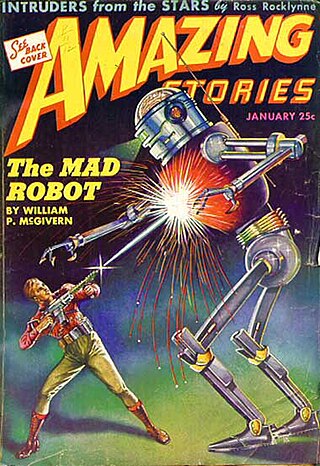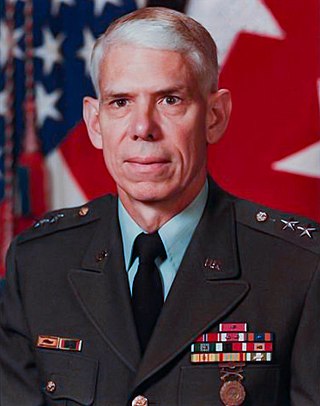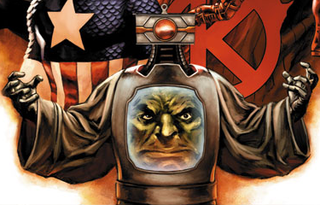
Starship Troopers is a military science fiction novel by American writer Robert A. Heinlein. Written in a few weeks in reaction to the US suspending nuclear tests, the story was first published as a two-part serial in The Magazine of Fantasy & Science Fiction as Starship Soldier, and published as a book by G. P. Putnam's Sons on November 5, 1959.
The Stargate Project was a secret U.S. Army unit established in 1978 at Fort Meade, Maryland, by the Defense Intelligence Agency (DIA) and SRI International to investigate the potential for psychic phenomena in military and domestic intelligence applications. The project, and its precursors and sister projects, originally went by various code names – 'Gondola Wish', 'Stargate', 'Grill Flame', 'Center Lane', 'Project CF', 'Sun Streak', 'Scanate' – until 1991 when they were consolidated and rechristened as the "Stargate Project".

Strange and exotic weapons are a recurring feature in science fiction. In some cases, weapons first introduced in science fiction have been made a reality; other science-fiction weapons remain purely fictional, and are often beyond the realms of known physical possibility.

The space marine, an archetype of military science fiction, is a kind of soldier who operates in outer space or on alien worlds. Historical marines fulfill multiple roles: ship defence, boarding actions, landing parties, and general-purpose high-mobility land deployments that operate within a fixed distance of shore or ship. By analogy, hypothetical space marines would defend allied spaceships, board enemy ships, land on planets and moons, and satisfy rapid-deployment needs throughout space.

Deathlok is the name of several fictional characters appearing in American comic books published by Marvel Comics. The first Deathlok, Luther Manning, appeared in Astonishing Tales #25, created by Rich Buckler. At least five subsequent Marvel characters have used the "Deathlok" identity since then: Michael Collins, Jack Truman, Rebecca Ryker, Henry Hayes, and Jemma Simmons. A recurring theme among these characters is that a dead human has been reanimated with cybernetic technology. "Deathlok technology" has also been used thematically by Marvel writers in other stories.

Daniel P. Abnett is an English comic book writer and novelist. He has been a frequent collaborator with fellow writer Andy Lanning, and is known for his work on books for both Marvel Comics, and their UK imprint, Marvel UK, since the 1990s, and also 2000 AD. He has also contributed to DC Comics titles, and his Warhammer Fantasy and Warhammer 40,000 novels and graphic novels for Games Workshop's Black Library now run to several dozen titles and have sold over two million copies. In 2009 he released his first original fiction novels through Angry Robot books.

Jon Ronson is a British-American journalist, author, and filmmaker whose works include Them: Adventures with Extremists (2001), The Men Who Stare at Goats (2004), and The Psychopath Test (2011). He has been described as a gonzo journalist, becoming a faux-naïf character in his stories. He produces informal but sceptical investigations of controversial fringe politics and science. He has published nine books and his work has appeared in publications such as The Guardian, City Life and Time Out. He has made several BBC Television documentary films and two documentary series for Channel 4.

The Kree, briefly known as the Ruul, are a fictional alien race appearing in American comic books published by Marvel Comics. They are native to the planet Hala in the Large Magellanic Cloud, and have a scientifically and technologically advanced militaristic society.
Weapon Plus is a fictional clandestine program appearing in American comic books published by Marvel Comics. It was created by Grant Morrison during their run in New X-Men. The program's purpose is the creation of super-soldiers intended to fight the wars of the future, especially a mutant-human war. Weapon X, the organization's most well-known program, was originally the tenth installation, but eventually it branched off and became an independent program with similar purposes. Morrison's introduction of Weapon Plus also shed new information about the origins of Weapon X, Captain America and other Marvel Comics supersoldiers.
Bucky is the name used by several different fictional characters appearing in American comic books published by Marvel Comics, usually as a sidekick to Captain America. The original version was created by Joe Simon and Jack Kirby and first appeared in Captain America Comics #1, which was published by Marvel's predecessor, Timely Comics. Following the apparent death of the hero James "Bucky" Barnes, the Bucky nickname and costume have been used by various heroes including: Fred Davis, Jack Monroe, Rick Jones, Lemar Hoskins, and Rikki Barnes. For a time, a child looked after by Jack Monroe was named "Bucky," but she was later adopted and given the name Julia Winters.
The First Earth Battalion was the name proposed by Lieutenant Colonel Jim Channon, a U.S. soldier who had served in Vietnam, for his idea of a new military of supersoldiers to be organized along New Age lines. A book of the same name was published in 1982.

Starship Troopers 2: Hero of the Federation is a 2004 American military science fiction horror film directed by Phil Tippett and starring Richard Burgi, Lawrence Monoson, and Colleen Porch. It is a sequel to Starship Troopers (1997) and the second installment of the Starship Troopers franchise. The film premiered on Encore Action on April 24, 2004, and was released on DVD and VHS on June 1, 2004. The film received generally negative reviews from critics, who criticized the shift from the first film's action to horror, as well as the lack of returning cast from the first film. It was followed by the direct-to-video sequel Starship Troopers 3: Marauder in 2008.

Albert "Bert" Newton Stubblebine III was a United States Army major general whose active-duty career spanned 32 years. Beginning as an armor officer, he later transferred to intelligence. He is credited with redesigning the U.S. Army intelligence architecture during his time as commanding general of the U.S. Army Intelligence and Security Command (INSCOM) from 1981 to 1984, after which he retired from active service.

Nuke is a fictional supervillain appearing in American comic books published by Marvel Comics. Created by writer Frank Miller and artist David Mazzucchelli, the character first appeared in Daredevil #232. Nuke's most distinguishing feature is an American Flag tattooed on his face.

Arnim Zola is a supervillain appearing in American comic books by Marvel Comics. He is a master of biochemistry and a recurring enemy of Captain America and the Avengers. The character first appeared in Captain America and the Falcon #208, and was created by writer/artist Jack Kirby. When he was first introduced, Zola was a Nazi scientist experimenting with genetic engineering during World War II. His skills as a geneticist drew the attention of the Red Skull, who recruited him into Hydra to aid their efforts to create super soldiers. One of his experiments led to the brain of Adolf Hitler being copied into a being later known as Hate-Monger. Later in life, Zola transferred his own mind into a sophisticated robot body which protected it by storing it in its chest and displaying a digital image of Zola's face on its chest plate. This robot body allowed Zola to survive until modern times, as whenever it is destroyed, Zola could simply upload his consciousness into a new body.
James B. Channon was a U.S. Army lieutenant colonel, New Age futurologist, and business consultant. He was primarily known for authoring the First Earth Battalion Operations Manual, a popular book pointing the way toward a New Age transformation in the U.S. military. The graphic-heavy publication was inspired by Stewart Brand's Whole Earth Catalog.

The Men Who Stare at Goats (2004) is a non-fiction book by Jon Ronson concerning the U.S. Army's exploration of New Age concepts and the potential military applications of the paranormal. The title refers to attempts to kill goats by staring at them and stopping their hearts. The book is a companion to a three-part TV series broadcast in Britain on Channel 4—Crazy Rulers of the World (2004)—the first episode of which is also entitled "The Men Who Stare at Goats". The same title was used a third time for a loose feature film adaptation in 2009.
Sleeper is the name of several fictional characters appearing in American comic books published by Marvel Comics. The first Sleeper is the name of a series of five destructive robots created by the Red Skull. The second Sleeper is a Symbiote.

The Men Who Stare at Goats is a 2009 satirical black comedy war film directed by Grant Heslov, adapted by Peter Straughan, and starring George Clooney, Ewan McGregor, Jeff Bridges, and Kevin Spacey. It was produced by Clooney's and Heslov's production company Smokehouse Pictures. The film is a fictionalized version of Jon Ronson's 2004 book of the same title of an investigation into attempts by the U.S. military to employ psychic powers as a weapon — which, in turn, is a companion to a British miniseries Crazy Rulers of the World.
Guy Savelli was a martial artist, teacher, and spiritual healer. He taught the spiritual and mental aspects of martial arts, especially Kuntao.













